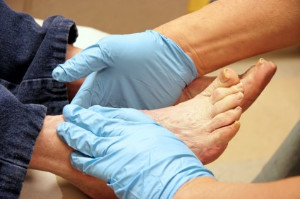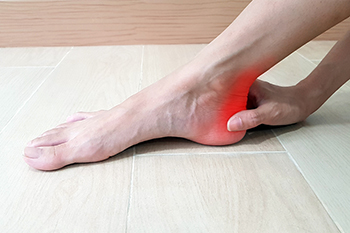Items filtered by date: March 2024
Diabetic Foot Problems and Quality of Life

Diabetic foot problems pose significant challenges to an individual's quality of life due to their potential for severe complications. Diabetes can lead to neuropathy, reduced blood flow, and impaired wound healing, increasing the risk of foot ulcers, infections, and even amputations. These conditions often cause chronic pain, limited mobility, and decreased independence, impacting daily activities and overall well-being. Furthermore, managing diabetic foot problems requires rigorous self-care routines, frequent medical appointments, and lifestyle adjustments, which can be physically and emotionally demanding. The fear of potential complications and the burden of constant vigilance over foot health can contribute to anxiety, depression, and decreased social participation. Effective management strategies, including proper foot care, regular monitoring, and early intervention for any issues, are essential for preserving mobility and minimizing the impact of diabetic foot problems on quality of life. If you have diabetes and it has impacted your feet, it is strongly suggested that you are under the care of a podiatrist for routine visits, in addition to receiving prompt treatment as needed.
Diabetic foot care is important in preventing foot ailments such as ulcers. If you are suffering from diabetes or have any other concerns about your feet, contact one of our podiatrists from Itasca Foot & Ankle. Our doctors can provide the care you need to keep you pain-free and on your feet.
Diabetic Foot Care
Diabetes affects millions of people every year. The condition can damage blood vessels in many parts of the body, especially the feet. Because of this, taking care of your feet is essential if you have diabetes, and having a podiatrist help monitor your foot health is highly recommended.
The Importance of Caring for Your Feet
- Routinely inspect your feet for bruises or sores.
- Wear socks that fit your feet comfortably.
- Wear comfortable shoes that provide adequate support.
Patients with diabetes should have their doctor monitor their blood levels, as blood sugar levels play such a huge role in diabetic care. Monitoring these levels on a regular basis is highly advised.
It is always best to inform your healthcare professional of any concerns you may have regarding your feet, especially for diabetic patients. Early treatment and routine foot examinations are keys to maintaining proper health, especially because severe complications can arise if proper treatment is not applied.
If you have any questions please feel free to contact our offices located in Itasca and Hoffman Estates, IL . We offer the newest diagnostic and treatment technologies for all your foot and ankle needs.
Do You Suffer From Painful Feet?
Plantar Fasciitis and Heel Pain
 Plantar fasciitis is a primary cause of heel pain in adults. The pain stems from the inflammation of the plantar fascia, a band of tissue that spans the bottom of the foot and connects the heel bone to the toes. This condition typically results from repetitive strain and overstretching of the plantar fascia. It is often exacerbated wearing inadequate footwear, obesity, and activities that place excessive stress on the foot. The pain is usually most intense with the first few steps in the morning or after periods of rest. It stems from micro-tears and inflammation within this critical support structure of the foot. As the plantar fascia bears the brunt of every step's impact, its compromised state can significantly hinder mobility and quality of life. Effective management and treatment hinge on a comprehensive approach that may include rest, anti-inflammatory medications, stretching exercises, and possibly orthotic support. If you are suffering from heel pain, it is suggested that you consult with a podiatrist. This type of doctor has specialized knowledge of the foot and ankle, and can diagnose plantar fasciitis and offer personalized treatment solutions.
Plantar fasciitis is a primary cause of heel pain in adults. The pain stems from the inflammation of the plantar fascia, a band of tissue that spans the bottom of the foot and connects the heel bone to the toes. This condition typically results from repetitive strain and overstretching of the plantar fascia. It is often exacerbated wearing inadequate footwear, obesity, and activities that place excessive stress on the foot. The pain is usually most intense with the first few steps in the morning or after periods of rest. It stems from micro-tears and inflammation within this critical support structure of the foot. As the plantar fascia bears the brunt of every step's impact, its compromised state can significantly hinder mobility and quality of life. Effective management and treatment hinge on a comprehensive approach that may include rest, anti-inflammatory medications, stretching exercises, and possibly orthotic support. If you are suffering from heel pain, it is suggested that you consult with a podiatrist. This type of doctor has specialized knowledge of the foot and ankle, and can diagnose plantar fasciitis and offer personalized treatment solutions.
Many people suffer from bouts of heel pain. For more information, contact one of our podiatrists of Itasca Foot & Ankle. Our doctors can provide the care you need to keep you pain-free and on your feet.
Causes of Heel Pain
Heel pain is often associated with plantar fasciitis. The plantar fascia is a band of tissues that extends along the bottom of the foot. A rip or tear in this ligament can cause inflammation of the tissue.
Achilles tendonitis is another cause of heel pain. Inflammation of the Achilles tendon will cause pain from fractures and muscle tearing. Lack of flexibility is also another symptom.
Heel spurs are another cause of pain. When the tissues of the plantar fascia undergo a great deal of stress, it can lead to ligament separation from the heel bone, causing heel spurs.
Why Might Heel Pain Occur?
- Wearing ill-fitting shoes
- Wearing non-supportive shoes
- Weight change
- Excessive running
Treatments
Heel pain should be treated as soon as possible for immediate results. Keeping your feet in a stress-free environment will help. If you suffer from Achilles tendonitis or plantar fasciitis, applying ice will reduce the swelling. Stretching before an exercise like running will help the muscles. Using all these tips will help make heel pain a condition of the past.
If you have any questions please contact our offices located in Itasca and Hoffman Estates, IL . We offer the newest diagnostic and treatment technologies for all your foot and ankle needs.
Achilles Tendon Pain

If you are experiencing pain in the back of your heel, you may have injured your Achilles tendon. This tendon, named after the legendary Greek warrior Achilles, connects the calf muscles to the heel bone. Achilles tendon injuries are common among athletes, particularly in sports like basketball and soccer. Symptoms include pain in the back of the heel or up the back of the leg, ranging from mild to severe. These injuries can occur in different places along the tendon, with the most serious being Achilles tendinopathy, which involves chronic inflammation and fluid buildup. Treatment typically involves rest, gentle stretching, and strengthening exercises. Prevention strategies include paying attention to foot mechanics, adjusting running stride, and building flexibility and strength in the lower legs through targeted exercises. If you are experiencing pain in your Achilles tendon area, it is suggested that you make an appointment with a podiatrist for an evaluation and treatment.
Achilles tendon injuries need immediate attention to avoid future complications. If you have any concerns, contact one of our podiatrists of Itasca Foot & Ankle. Our doctors can provide the care you need to keep you pain-free and on your feet.
What Is the Achilles Tendon?
The Achilles tendon is a tendon that connects the lower leg muscles and calf to the heel of the foot. It is the strongest tendon in the human body and is essential for making movement possible. Because this tendon is such an integral part of the body, any injuries to it can create immense difficulties and should immediately be presented to a doctor.
What Are the Symptoms of an Achilles Tendon Injury?
There are various types of injuries that can affect the Achilles tendon. The two most common injuries are Achilles tendinitis and ruptures of the tendon.
Achilles Tendinitis Symptoms
- Inflammation
- Dull to severe pain
- Increased blood flow to the tendon
- Thickening of the tendon
Rupture Symptoms
- Extreme pain and swelling in the foot
- Total immobility
Treatment and Prevention
Achilles tendon injuries are diagnosed by a thorough physical evaluation, which can include an MRI. Treatment involves rest, physical therapy, and in some cases, surgery. However, various preventative measures can be taken to avoid these injuries, such as:
- Thorough stretching of the tendon before and after exercise
- Strengthening exercises like calf raises, squats, leg curls, leg extensions, leg raises, lunges, and leg presses
If you have any questions please feel free to contact our offices located in Itasca and Hoffman Estates, IL . We offer the newest diagnostic tools and technology to treat your foot and ankle needs.
Ankle Joint Replacement Surgery

Total ankle replacement is a surgical procedure that can be performed by podiatrists to address ankle arthritis, whether it stems from aging or injury. This intervention involves replacing the damaged ankle joint with a synthetic implant made of metal and plastic, with the goal of relieving pain and restoring mobility. Unlike ankle fusion surgery, total ankle joint replacement aims to preserve joint motion. Candidates for this procedure typically include patients who have tried and failed non-surgical treatments and continue to experience persistent ankle pain and functional limitations. However, certain factors, such as severe deformity or compromised bone integrity, may influence treatment decisions. Recovery from total ankle replacement involves a period of non-weight bearing, followed by gradual rehabilitation. The ankle replacement procedure carries risks like infection and implant failure, that a podiatrist can help manage. If you are suffering from ankle arthritis and exploring treatment options, it is suggested that you consult with a podiatrist to discuss whether total ankle replacement may be the right choice for you.
In certain cases, in which the patient suffers from extreme pain or damage in a joint, joint replacement surgery may be deemed useful. If you have constant pain in a foot joint, consult with one of our podiatrists from Itasca Foot & Ankle. Our doctors will assess your condition and provide you with quality foot and ankle treatment.
What Is Joint Replacement Surgery?
Over time, joints wear down; this can be exacerbated by diseases and conditions. Joint replacement surgery, also known as arthroplasty, is when a damaged joint is surgically removed and replaced with a prosthesis. Prostheses, which can be made of ceramic, plastic, or metal, act as joints in lieu of an actual joint. One of the most prevalent causes for joint replacement is arthritis.
Arthritis in the Foot
Arthritis can occur in any joint in the body, including in the feet. Common types of arthritis in the foot are osteoarthritis, rheumatoid arthritis, and gout. The big toe is usually where arthritis occurs in the foot; this is known as hallux rigidus.
Joint Replacement Surgery in the Foot
The most common form of joint replacement in the foot is a first metatarsophalangeal (MTP) joint placement. MTP joint replacement surgery is designed to treat hallux rigidus. Surgery is not intensive, and recovery occurs within one to two months after the procedure has been done. Overall, joint replacement surgery is a safe and effective way to treat pain in the joint of the foot.
If you have any questions, please feel free to contact our offices located in Itasca and Hoffman Estates, IL . We offer the newest diagnostic and treatment technologies for all your foot care needs.
